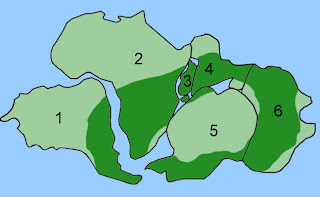"If animals were specially created, why would the creator produce on different continents fundamentally different animals that nevertheless look and act so much alike?"Perhaps the habitats are subtly different, such that the marsupials couldn't have survived in the Americas (and vice versa)? Unfortunately for the creationists, no. Various plant and animal species often thrive when introduced onto a new continent. In truth, the pattern we see is explained quite well through a combination of speciation and convergent evolution. Coyne explains that we find the earliest fossil marsupials (80 million years ago) in North America. They then migrated down into South America (40 mya) and eventually found their way to Australia (30 mya). From there, convergent evolution kicked in: traits that are extremely useful in certain habitats will tend to evolve independently. This explains, for example, why gliding flaps can be found in both flying squirrels and the marsupial sugar glider.
1: South America; 2: Africa; 3: Madagascar; 4: India; 5: Antarctica; 6: Australia |
Some of the less savvy YECs probably deny continental drift altogether, but with evidence like this, the facts are hard to ignore. As I mentioned here, the accelerated young-earth version of this drift is both arbitrary and completely impossible. In contrast, both the biogeographical patterns and continental drift are beautifully consistent with (and even strengthen) evolutionary theory.
I had hoped to cover this whole chapter in one shot, but there's so much material that I'll have to split it in two. I'll summarize the biogeographical evidence from islands in the next installment.

I really enjoyed your blog posts, thank you
ReplyDelete